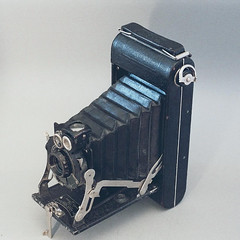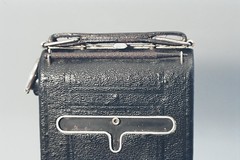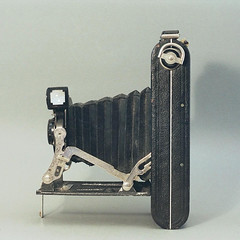Difference between revisions of "Pocket Kodak No. 1 series II"
m |
m (→Transport) |
||
| Line 22: | Line 22: | ||
[http://www.flickr.com/photos/50678983@N00/168465075/in/pool-camerapedia http://static.flickr.com/64/168465075_ada56baa05_m.jpg] | [http://www.flickr.com/photos/50678983@N00/168465075/in/pool-camerapedia http://static.flickr.com/64/168465075_ada56baa05_m.jpg] | ||
</div> | </div> | ||
| − | The film is wound by a lug on top of the camera. Just wind untill the next framenumber apperas in the red window in the back. Naturally, the shutter has to be cocked seprately on the lens. | + | The film is wound by a lug on top of the camera. Just wind untill the next framenumber apperas in the red window in the back. Naturally, the shutter has to be cocked seprately, on the lens. |
| + | |||
== images == | == images == | ||
<div> | <div> | ||
Revision as of 21:48, 16 June 2006
The pocket Kodak No. 1 series II is a folding A120 film camera from the early years of the 20th century. It uses autographic rollfilm that was produced by Eastman Kodak between 1914 and 1934. There's a patent statement dating from 1916 on the body so it can't be earlier than 1916. The negative size is 6×9 cm or 2 1/4× 3 1/4 inch. It has a Kodak anastigmat 108/7,7 lens. That's not a fast lens. The Diomatic No. 0 shutter has six settings, B, T 1/10 1/50 1/100 and 1/200s. That's not bad at all. It even has an exposure advice. Select aperture and lighting conditions dull, gray, clear or brillant. At the shown aperture "figures indicate required exposure" as it states on the lever.
The camera was disigned to use A120 film. To benefit from this autographic feature, a stylus with an Art Deco look was included (just above the window). Very often the stylus is lost on cameras you find at photographica fairs. On the back of the camera, you find the obvious red windows used for framecounting. On this camera, a little advice was imprinted in the black leather: use film No A120. Nowadays, all you can use is simple 120 film.
Viewfinder
The finder is a prism that, when looked at from a distance, gives you an idea of framing. The prism can be put in a horizontal or vertical position, so composing can be done by looking into it from above or from the side of the camera. The prism field is shows swiss cross for portrait or landscape pictures.
Transport
The film is wound by a lug on top of the camera. Just wind untill the next framenumber apperas in the red window in the back. Naturally, the shutter has to be cocked seprately, on the lens.





